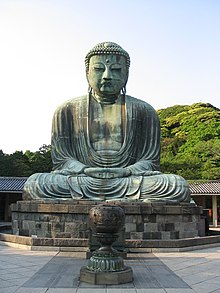
Kotoku-in (Jap. 高 徳 院) is a Buddhist temple of jodo school in the city of Kamakura in Kanagawa prefecture, Japan .
The temple is known for its "Big Buddha " (大 仏, " daibutsu "), a monumental open bronze statue of Amitabha Buddha, which is one of the most famous symbols of Japan.
The bronze statue probably dates from the year 1252, that is, the Kamakura period , according to temple records. This was preceded by a giant wooden statue of Buddha, which was completed in 1243 after ten years of uninterrupted labor, funds came from Princess Inana (Inan-no-Tsubone) and Buddhist monk Jyoko from Totomi. This wooden statue was destroyed by a storm in 1248, and the hall in which it was located was also destroyed, so Joko offered to make another statue from bronze; also a huge amount of money needed for this and for the new hall was invested in the project [1] . The bronze statue was probably made by Oono Goroemon [2] or Tangzi Hisatomo [3] , the leading Japanese bronze sculptors of the time [4] . In a certain period of time, the statue was gilded. There are still traces of gilding near the statue's ears [5] . It is not clear, however, whether the statue created in 1252 is the same statue that is available now.
The hall was destroyed by a storm in 1334, was restored, after which it was damaged by another storm in 1369 and was restored again. The last building that contained the statue was washed away by a tsunami on September 20, 1498, during the Muromachi period . Since then, the Big Buddha has been standing outdoors.
The statue is about 13.35 meters tall, including the base [6] , and weighs about 93 tons. The statue is hollow, and visitors can explore its interior. Many visitors for many years left inscriptions on the inside of the statue [7] . At one time, there were thirty-two bronze petals of a lotus at the foot of the statue, but to date only four have been preserved, and all of them are not in the original place [8] .
The great Kanto earthquake of 1923 destroyed the foundation on which the statue sits, but it was restored in 1925. Repair of the monument was carried out in 1960-1961, when the neck was strengthened, and measures were taken to protect the statue from earthquakes.
Notes
- ↑ Daibutsu: The Great Buddha of Kamakura / Takao Sato. - Hobundo. - P. 7.
- ↑ Frédéric, Louis. Japan Encyclopedia Harvard University Press (2005). p.755
- ↑ Kate Tsubata . The Great Buddha at Kamakura , The Washington Times (May 25, 2008). Archived June 7, 2011. Retrieved 2011-09-20.
- New The New Official Guide, Japan Japan Travel Bureau (1975) p.404
- ↑ Kotoku-in (The Great Buddha) . Kamakura Today (2002). Archived September 24, 2012. Accessed 2011-09-20.
- An "An Overview of the Great Buddha" Kotoku-in Official Website. Accessed 2011-09-20.
- ↑ Daibutsu: The Great Buddha of Kamakura / Takao Sato. - Hobundo. - P. 14.
- ↑ Daibutsu: The Great Buddha of Kamakura / Takao Sato. - Hobundo. - P. 16.